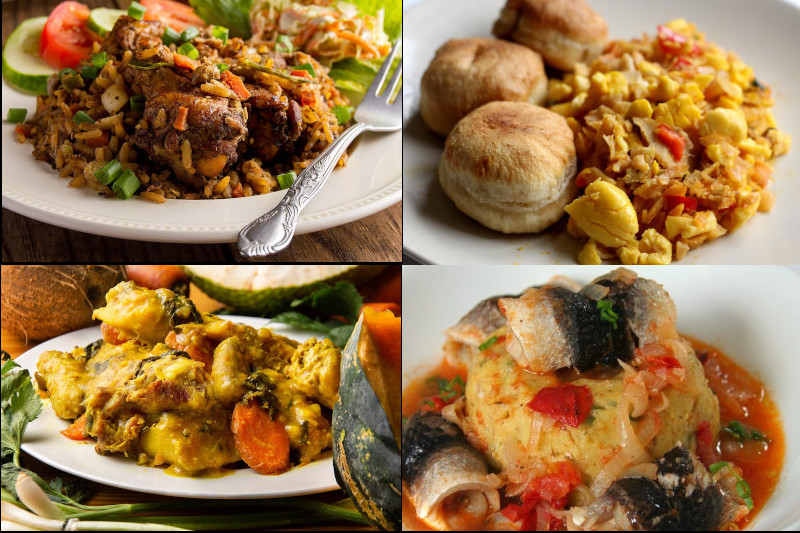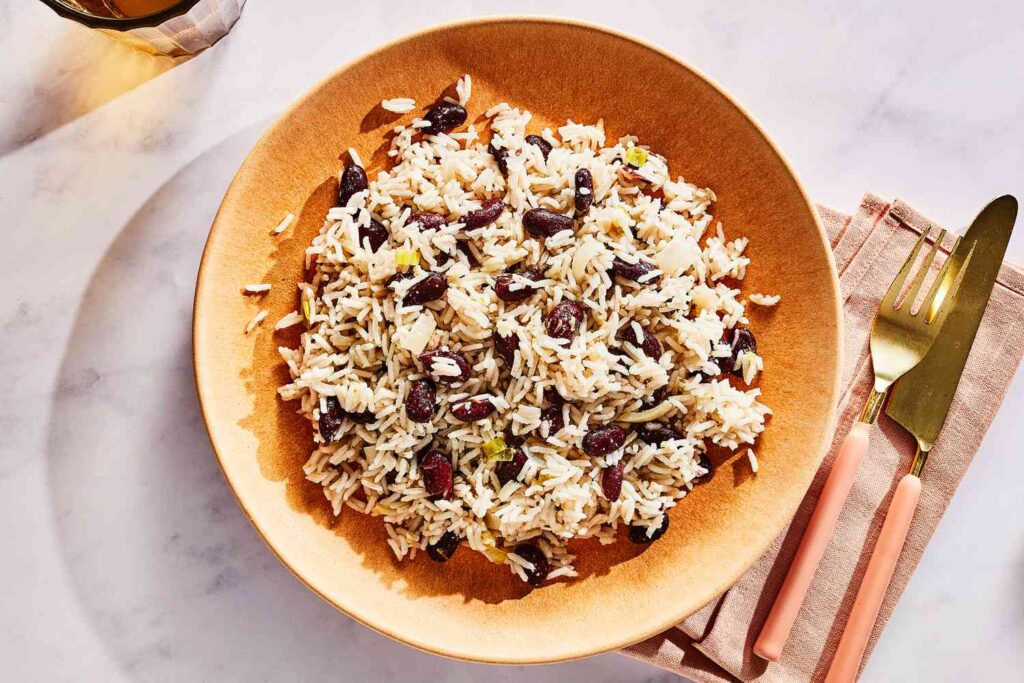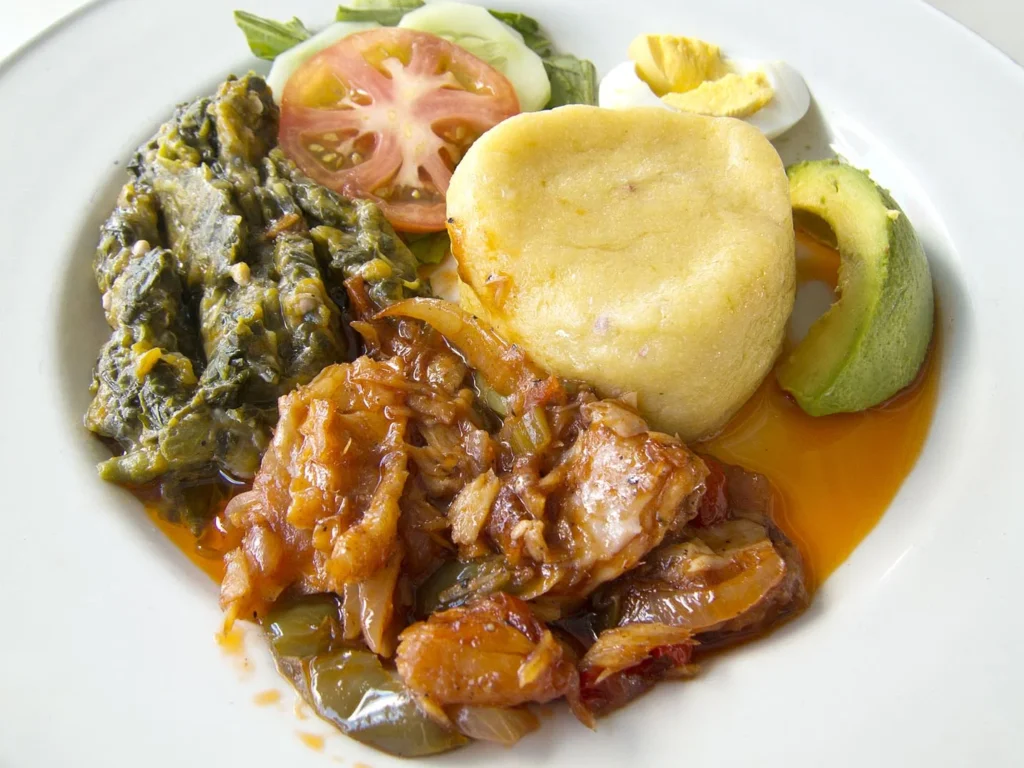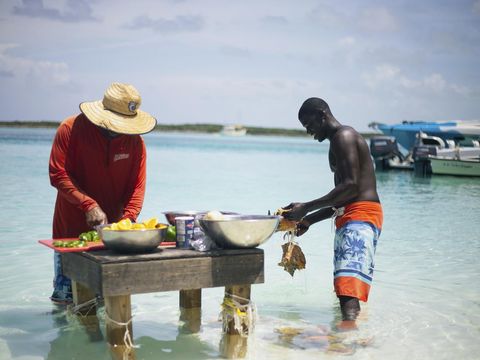Featured
- Get link
- X
- Other Apps
National dishes of all Caribbean countries
The Caribbean archipelago is a mosaic of flavors, each island offering a distinct dish that tells a story of its history, people, and natural bounty. These national dishes are not just food; they’re cultural emblems, each bite a testament to the traditions that have simmered in the Caribbean pot for centuries.
In this journey through the national dishes of all Caribbean countries, we’ll traverse the diverse culinary landscapes, from the hearty stews of Jamaica to the spice-laden broths of Grenada.
We’ll uncover the secrets behind these beloved recipes and the ingredients that give them life. Join us as we embark on a flavorful adventure, celebrating the dishes that are the heart and soul of Caribbean nations.

The Culinary Tapestry of the Caribbean
The Caribbean’s culinary landscape is as rich and varied as its many islands, each a unique blend of flavors and traditions. At the heart of this diversity is a shared history that has woven together the tastes of Africa, Europe, Asia, and the Americas into a vibrant culinary tapestry.

Historical Influences
The story of Caribbean cuisine is a chronicle of conquest, colonization, and the blending of cultures. From the indigenous Taino and Arawak peoples to the European settlers and African slaves, each group brought with them their culinary practices, ingredients, and traditions. The result is a cuisine that is both diverse and unified, with each island adding its own distinct flavor to the mix.
A Melting Pot of Flavors
Caribbean food is a testament to the region’s ability to absorb and adapt influences from around the world. African yams and plantains, Indian curries, Spanish sofrito, and Chinese stir-fry techniques all find a place in the Caribbean kitchen. This fusion creates dishes that are both familiar and entirely new, with each bite telling the story of a journey across oceans and continents.
Ingredients: The Building Blocks of Taste
The natural bounty of the Caribbean provides a rich palette of flavors for the region’s cooks. Seafood from the surrounding waters, tropical fruits from the lush forests, and spices and herbs from the fertile earth all contribute to the distinctive tastes of Caribbean cuisine. These ingredients are not just sustenance but symbols of the islands’ abundance and diversity.
Cooking Techniques: Tradition Meets Innovation
Traditional cooking methods like jerk smoking and slow stewing are still widely used, preserving the flavors of the past. But Caribbean chefs are also innovators, constantly experimenting with new techniques and combinations. Whether it’s a street vendor grilling fresh fish or a fine dining chef creating a fusion masterpiece, the spirit of creativity is alive in the Caribbean kitchen.
The Role of Food in Caribbean Culture
In the Caribbean, food is more than just nourishment; it is a celebration of life and community. Festivals, family gatherings, and even everyday meals are opportunities to come together and share in the joy of eating. Each dish is a reminder of the islands’ history and a symbol of their vibrant present and promising future.
National dishes of all Caribbean countries: Island-by-Island Flavor Profiles
The Caribbean is a symphony of flavors, each island composing its own culinary masterpiece. Let’s embark on a gastronomic tour, island by island, to discover the unique flavor profiles that make Caribbean cuisine a world-renowned affair.
Jamaica: The Spicy Heartbeat

Jamaica’s cuisine pulsates with the heat of scotch bonnet peppers and the warmth of allspice. Jerk chicken, the island’s flagship dish, marries the fiery kick of its marinade with the smokiness of pimento wood grilling. This dish is not just food; it’s a narrative of Jamaica’s history, from the indigenous Taino to the Maroons’ fight for freedom.
Trinidad and Tobago: A Melodic Fusion
In Trinidad and Tobago, the rhythm of Indian dholaks resonates in their national dish, curry crab and dumplings. The curry’s complex spices sing alongside the subtle sweetness of the crab, creating a harmonious blend that reflects the island’s Indian and African heritage.

Barbados: The Sweet Refrain
Flying fish and cou-cou, Barbados’ national dish, is a melody of textures and flavors. The ocean’s bounty, flying fish, is seasoned and fried until golden, then served with cou-cou, a cornmeal, and okra concoction, creating a chorus of savory and earthy notes.

Haiti: The Soulful Chorus
Haitian cuisine offers a soulful chorus of flavors with its national dish, griot with pikliz. Griot, succulent pieces of marinated pork fried to perfection, is paired with pikliz, a spicy pickled vegetable medley. This combination sings of Haiti’s resilience and zest for life.

Cuba: The Rhythmic Dance
Ropa vieja, Cuba’s beloved dish, is like a rhythmic dance of flavors. Shredded beef simmers in a tomato-based sauce infused with bell peppers, onions, and a blend of spices, narrating the island’s Spanish influence through its vibrant taste and colors.

The Bahamas: The Calypso Beat
Conch fritters, the Bahamian specialty, carry the calypso beat of the islands in their crispy exterior and tender interior. The conch’s mild flavor is enhanced with a mix of local spices and lime juice, encapsulating the laid-back yet spirited essence of the Bahamas.

Saint Lucia: The Creole Ballad
Saint Lucia’s Green Fig and Saltfish is a Creole ballad that tells of the island’s bountiful produce and sea harvest. Green bananas, known locally as ‘figs,’ are boiled and served with flaked saltfish, creating a simple yet profound melody of flavors.

A Taste of the Islands: National Dishes
The Caribbean is not just a paradise of sun, sea, and sand; it’s a culinary hotspot where every meal tells a story. Here’s a closer look at the national dishes that define the Caribbean’s rich cultural tapestry.
Anguilla: Pigeon Peas and Rice
In Anguilla, pigeon peas and rice are not just dishes; they are celebrations of the island’s agricultural roots. The peas, bursting with flavor, are often prepared with fresh herbs, onions, and garlic, creating a comforting staple that’s both simple and profound.
Antigua and Barbuda: Fungi and Pepperpot
Fungi and pepperpot is a hearty meal that embodies the soul of Antigua and Barbuda. Cornmeal and okra meet a medley of mixed meats in a dish that’s as robust as the island’s history.



Aruba: Keshi Yena
Aruba’s Keshi Yena is a testament to creativity in the kitchen. This large, round ball of cheese is stuffed with spiced meat, reflecting the island’s Dutch colonial past and its penchant for bold flavors.
Bahamas: Cracked Conch with Peas and Rice
The Bahamas’ cracked conch with peas and rice is a dive into the archipelago’s oceanic bounty. The tender conch, paired with the earthiness of peas and rice, captures the essence of Bahamian sea-to-table dining.
Barbados: Cou Cou and Flying Fish
Cou and flying fish are Barbados’ culinary flag. The smooth texture of cornmeal and okra’s cou cou complements the delicate flying fish, creating a dish that’s as vibrant as the island’s coral reefs.
Belize: Rice and Beans With Fish Stew
Belize’s rice and beans with fish stew is a melody of flavors that sings of the Central American and Caribbean blend. The coconut milk-infused rice and beans lay the foundation for a rich and savory fish stew.
British Virgin Islands: Fish and Fungi
The British Virgin Islands’ fish and fungi is a humble yet flavorful dish. Cornmeal and okra come together in thick, comforting fungi, served alongside fresh, steamed fish—a true taste of the islands’ natural resources.
Cayman Islands: Turtle
In the Cayman Islands, turtle meat is a traditional delicacy. While controversial, it reflects the island’s history and is a reminder of the importance of sustainable practices in enjoying local cuisine.
Cuba: Ropa Vieja
Cuba’s ropa vieja is a colorful tapestry of flavors. Shredded beef, simmered in a tomato-based sauce with bell peppers and onions, tells the story of the island’s Spanish influence and its love for hearty, satisfying meals.
Dominica: Mountain Chicken/Callaloo Soup
Dominica’s mountain chicken, also known as callaloo soup, is a dish steeped in the island’s lush landscape. The soup, rich with leafy greens and herbs, is a tribute to the island’s fertile volcanic soil.
Dominican Republic: Sancocho
Sancocho, from the Dominican Republic, is a culinary melting pot. This hearty stew, brimming with meats and root vegetables, is a symbol of the island’s diverse cultural heritage and communal spirit.
Grenada: Oil Down
Grenada’s oil down is the island’s comfort food. Breadfruit, salted meat, and aromatic spices stewed in coconut milk create a dish that’s as warming as the island’s tropical sun.
Haiti: Rice and Beans
Haiti’s rice and beans is a dish of resilience. Simple ingredients come together to form a staple that has sustained generations, reflecting the strength and spirit of the Haitian people.
Jamaica: Ackee and Saltfish
Ackee and saltfish are Jamaica’s national pride. The bold flavors of salted cod paired with the subtle, creamy ackee fruit is a testament to the island’s ability to turn simple ingredients into culinary gold.
Puerto Rico: Arroz con Gandules
Puerto Rico’s arroz con gandules is a festive dish. Pigeon peas and rice, seasoned with sofrito and annatto oil, is a celebration of the island’s vibrant culture and Spanish-African heritage.
St. Kitts and Nevis: Stewed Salt Fish with Dumplings
St. Kitts and Nevis’ stewed salt fish with dumplings is a dish of contrasts. The saltiness of the fish balanced with the soft, comforting dumplings creates a harmonious blend that’s as delightful as the twin-island nation itself.
St. Lucia: Green Figs and Salt Fish
St. Lucia’s green figs and salt fish are a nod to the island’s bountiful banana plantations and rich marine life. The green bananas and flaked fish create a dish that’s both nutritious and deeply satisfying.
Trinidad and Tobago: Crab and Callaloo
Trinidad and Tobago’s crab and callaloo is a dance of flavors. The spicy crab and velvety callaloo leaves stewed together result in a dish that’s as lively as the island’s famous carnival.
Turks and Caicos: Conch
In Turks and Caicos, conch is not just seafood; it’s a cultural icon. The mollusk, prepared in various ways, showcases the island’s ingenuity in creating dishes that are as diverse as its people.
U.S. Virgin Islands: Fish and Fungi
The U.S. Virgin Islands’ fish and fungi are a dish of simplicity and flavor. The fresh fish, paired with the hearty fungi, is a reminder of the islands’ rich history and the simplicity of Caribbean life.
Culinary Crossroads: Shared Dishes with a Twist

The Caribbean is a melting pot of cultures, and this is beautifully reflected in its cuisine. Shared dishes across the islands often come with a delightful twist, showcasing the unique interpretation of each culture.
Here’s a glimpse into some of these shared culinary treasures and the twists that make them uniquely Caribbean.
Pernil: The Puerto Rican Delight
Pernil, a succulent roasted pork shoulder, is a beloved dish in Puerto Rico. While it has its roots in Spanish cuisine, the Caribbean twist comes from the adobo mojado—a marinade of paprika, salt, vinegar, garlic, and oregano—that infuses the meat with a depth of flavor that’s distinctly Puerto Rican.
Peppered Shrimps: The Jamaican Street Food Classic
Peppered shrimps may be found in various forms across the Caribbean, but Jamaica’s version is particularly famous. Cooked with garlic, hot pepper, butter, and thyme, these shrimps pack a spicy punch that’s synonymous with the island’s love for bold flavors.
Tembleque: The Wiggly Puerto Rican Pudding
Tembleque is a creamy coconut milk pudding that’s popular in Puerto Rico. The Caribbean twist? It’s often flavored with local ingredients like vanilla, nutmeg, or rum, giving it a tropical flair that’s perfect for any festive occasion.
Brown Stew Chicken: A Jamaican Staple with Variations
Brown stew chicken is a dish that’s enjoyed in various forms throughout the Caribbean. In Jamaica, it’s a rich gravy made with onions, peppers, ketchup, and water, served with a side of rice, peas, and plantains. Each island adds its own touch, whether it’s the choice of spices or the method of preparation.
Callaloo: The Leafy Green of the Caribbean
Callaloo is a dish made from leafy greens and is integral to Caribbean cuisine. While it originated in West Africa, each island has its own version. Some use taro leaves, others spinach, and some even add seafood or coconut milk for an extra layer of flavor.
Jerk Seasoning: The Spice of Life in the Caribbean
Jerk seasoning is a prime example of a shared dish with a twist. While it’s most closely associated with Jamaica, other islands have adopted and adapted this spice blend, using local ingredients to create their own versions of jerk dishes.
Coquito: The Puerto Rican Holiday Cheer
Coquito is a coconut-based alcoholic beverage traditionally enjoyed in Puerto Rico during the holidays. The twist? Each family has its own recipe, often passed down through generations, with variations including different types of rum, spices, and levels of sweetness.
Final Analysis
The national dishes of all Caribbean countries are not just a feast for the palate but a vibrant narrative of the region’s history, culture, and soul. Each dish, from the spicy jerk chicken of Jamaica to the savory oil down of Grenada, tells a story of the island’s diverse heritage and the ingenuity of its people.
As we savor these flavors, we partake in a centuries-old tradition that continues to evolve, reflecting the spirit of the Caribbean—a region where food is celebrated as a vital thread in the fabric of daily life and community.
This culinary journey through the Caribbean offers a taste of the islands’ heartbeat, inviting us to appreciate the rich tapestry of tastes that is as colorful and dynamic as the Caribbean itself.
source https://sazonytumbao.com/national-dishes-of-all-caribbean-countries/
- Get link
- X
- Other Apps
Popular Posts
Street Food Culture in the Caribbean: A Culinary Journey
- Get link
- X
- Other Apps
Comments
Post a Comment